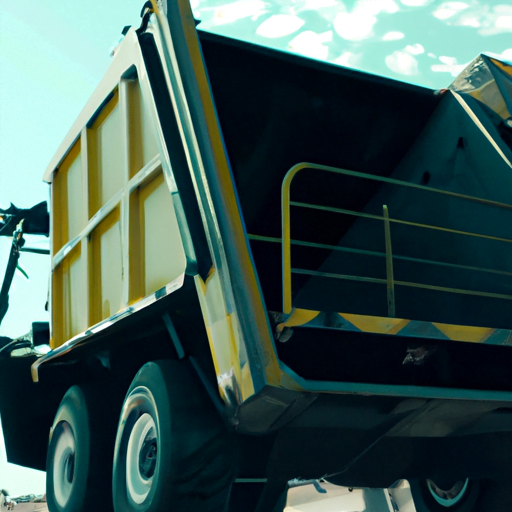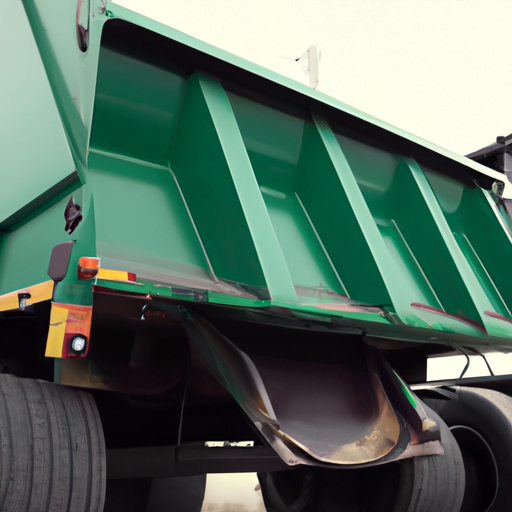-
Table of Contents
Introduction
The Evolution of Dump Trailers: A Look at the Industry’s Past, Present, and Future provides an in-depth exploration of the journey of dump trailers from their inception to their current state, and projects their potential advancements in the future. This comprehensive overview delves into the early designs and uses of these essential vehicles, the technological advancements that have shaped their modern form, and the innovative trends that are set to redefine their role in the construction, mining, and waste management industries. The narrative not only traces the historical progression of dump trailers but also examines the economic, environmental, and technological factors that have influenced their evolution.
The Evolution of Dump Trailers: Tracing the Industry’s Past, Present, and Future
The evolution of dump trailers is a fascinating journey that traces the industry’s past, present, and future. It’s a story of innovation and adaptation, driven by the ever-changing needs of industries such as construction, mining, and waste management.
In the early days, dump trailers were simple, manually operated vehicles. They were essentially horse-drawn carts with a box bed that could be tipped to unload materials. These rudimentary trailers were labor-intensive and time-consuming to operate, but they were a significant improvement over the previous method of manually shoveling materials out of a cart.
As the industrial revolution took hold in the late 19th and early 20th centuries, the demand for more efficient dump trailers grew. The advent of internal combustion engines led to the development of motorized dump trucks, which were faster and more efficient than their horse-drawn predecessors. These early motorized dump trailers featured a box bed that could be tipped to unload materials, much like the horse-drawn carts. However, they also introduced new features such as hydraulic systems to lift the bed, making unloading faster and easier.
The mid-20th century saw further advancements in dump trailer technology. Manufacturers began to experiment with different designs and materials to increase the trailers’ capacity and durability. Steel and later aluminum became the materials of choice for dump trailer beds due to their strength and light weight. The design of the trailers also evolved, with the introduction of semi-trailer dump trucks that could carry larger loads.
In recent years, the dump trailer industry has continued to innovate, driven by the increasing demands of modern industries. Today’s dump trailers are more efficient, durable, and versatile than ever before. They feature advanced hydraulic systems for faster unloading, and many are equipped with GPS technology for precise navigation. Some models even offer remote control operation, allowing operators to unload materials from a safe distance.
Looking to the future, the dump trailer industry is poised for even more innovation. As industries continue to evolve, so too will the trailers that serve them. One area of potential growth is in the development of environmentally friendly dump trailers. As industries strive to reduce their environmental impact, manufacturers are exploring ways to make dump trailers more energy-efficient and less polluting. This could involve the use of alternative fuels, such as electric or hydrogen power, or the development of trailers that can carry larger loads, reducing the number of trips needed and thus the amount of fuel used.
Another area of potential innovation is in the use of advanced technology. As we’ve seen with the introduction of GPS and remote control operation, technology can greatly enhance the efficiency and safety of dump trailers. Future advancements could include the use of autonomous driving technology, allowing dump trailers to operate without a human driver, or the use of advanced sensors to monitor the condition of the trailer and alert operators to potential problems.
In conclusion, the evolution of dump trailers is a story of continual innovation and adaptation. From the simple horse-drawn carts of the past to the advanced, high-tech trailers of today and tomorrow, the industry has continually evolved to meet the changing needs of its customers. As we look to the future, it’s clear that this trend of innovation and adaptation will continue, driving the industry forward and shaping the dump trailers of tomorrow.
Understanding the Evolution of Dump Trailers: A Comprehensive Look at the Past, Present, and Future
The evolution of dump trailers is a fascinating journey that reflects the progress of human ingenuity and technological advancement. From their humble beginnings to the modern marvels we see today, dump trailers have undergone significant transformations that have revolutionized the construction and transportation industries.
In the early days, dump trailers were simple, manually operated devices. They were essentially large boxes on wheels, which workers had to load and unload by hand. This was a labor-intensive process that required a great deal of physical strength and endurance. However, these early dump trailers were a significant improvement over the previous methods of transporting materials, such as using horse-drawn carts or carrying loads by hand.
As the industrial revolution took hold in the 19th century, the design and functionality of dump trailers began to evolve. The invention of the steam engine led to the development of the first mechanically operated dump trailers. These machines were able to carry larger loads and dump them more efficiently, reducing the amount of manual labor required. This was a major breakthrough that significantly increased productivity and efficiency in the construction and transportation industries.
The 20th century brought further advancements in dump trailer technology. The introduction of hydraulic systems allowed for even greater load capacity and dumping efficiency. These hydraulic dump trailers could be operated with the push of a button, making them much easier and safer to use. The development of stronger, more durable materials also led to the creation of larger, more robust dump trailers that could withstand the rigors of heavy-duty work.
Today, dump trailers are sophisticated machines that incorporate cutting-edge technology. Many modern dump trailers are equipped with advanced features such as GPS tracking, automatic load balancing, and remote control operation. These features not only enhance the functionality of the dump trailers but also improve safety and efficiency.
Looking ahead, the future of dump trailers is likely to be shaped by ongoing technological advancements. The rise of automation and artificial intelligence could lead to the development of fully autonomous dump trailers that can operate without human intervention. This would further increase efficiency and productivity, while also reducing the risk of accidents and injuries.
Moreover, as sustainability becomes an increasingly important concern, we can expect to see the development of more environmentally friendly dump trailers. This could involve the use of renewable energy sources, such as solar or wind power, to operate the trailers. It could also involve the use of more sustainable materials in the construction of the trailers.
In conclusion, the evolution of dump trailers is a testament to human ingenuity and technological progress. From their simple beginnings to the advanced machines we see today, dump trailers have come a long way. As we look to the future, we can expect to see even more exciting developments in this vital industry. Whether it’s through automation, sustainability, or other technological advancements, the evolution of dump trailers is far from over.
The Journey of Dump Trailers: An Insight into the Evolution from Past to Future
The evolution of dump trailers is a fascinating journey that reflects the broader trends in the transportation and construction industries. From their humble beginnings to the high-tech marvels they are today, dump trailers have come a long way, and their story is far from over.
In the early days, dump trailers were simple, manually operated vehicles. They were essentially large boxes on wheels, with a mechanism to tip the box and dump its contents. These early models were often horse-drawn, and they were used primarily for agricultural purposes, such as transporting grain or manure. The process was labor-intensive and time-consuming, but it was a significant improvement over carrying loads by hand or in small carts.
As the industrial revolution took hold, the design and functionality of dump trailers evolved. The advent of steam power and later internal combustion engines allowed for larger, more powerful vehicles. The manual tipping mechanism was replaced with hydraulic systems, which made the dumping process faster and more efficient. These advancements were a game-changer for the construction industry, as they enabled the transport and disposal of large amounts of materials, such as dirt and rocks, in a relatively short amount of time.
The mid-20th century saw further improvements in dump trailer technology. The introduction of pneumatics and electronics led to even more efficient and reliable dumping mechanisms. The trailers themselves became larger and more robust, capable of carrying heavier loads. At the same time, safety features such as braking systems and protective cages for the driver became standard.
In recent years, the dump trailer industry has embraced digital technology. Modern dump trailers are equipped with GPS tracking, remote control operation, and automated loading and unloading systems. These features not only increase efficiency but also improve safety by reducing the risk of accidents. Furthermore, the use of lightweight, durable materials has allowed for the creation of larger, more fuel-efficient trailers.
Looking to the future, the dump trailer industry is poised to continue its evolution. The rise of electric vehicles and autonomous driving technology presents exciting opportunities for innovation. Imagine a fleet of self-driving dump trailers, powered by renewable energy, efficiently transporting materials around a construction site with minimal human intervention. This may sound like science fiction, but it’s a very real possibility given the current pace of technological advancement.
In addition to technological innovation, the dump trailer industry is also facing new challenges and opportunities in the realm of sustainability. As society becomes more aware of the environmental impact of construction and transportation, there is increasing pressure to develop more sustainable practices. This could mean everything from using recycled materials in the construction of trailers to implementing more efficient logistics strategies to reduce fuel consumption.
In conclusion, the journey of dump trailers from past to future is a testament to human ingenuity and the relentless drive for improvement. From simple, horse-drawn carts to high-tech, digitally controlled vehicles, dump trailers have evolved in tandem with the industries they serve. As we look to the future, it’s clear that this evolution is far from over. The dump trailer industry will continue to innovate, adapt, and grow, shaping and being shaped by the world around it.
Q&A
1. Question: How have dump trailers evolved in the past?
Answer: Dump trailers have evolved significantly over the years. Initially, they were simple, manually operated equipment. With the advent of technology, hydraulic systems were introduced which made the dumping process more efficient. The materials used for construction have also improved, with more durable and lightweight materials being used today.
2. Question: What is the current state of the dump trailer industry?
Answer: The current state of the dump trailer industry is characterized by technological advancements and increased efficiency. Modern dump trailers are equipped with advanced hydraulic systems for easier operation. They are also made with stronger, lighter materials for increased durability and load capacity. The industry is also focusing on producing more environmentally friendly models.
3. Question: What is the future of the dump trailer industry?
Answer: The future of the dump trailer industry is likely to be shaped by further technological advancements. This includes the integration of smart technology for better load management and operational efficiency. There is also a growing emphasis on sustainability, so we can expect to see the development of more eco-friendly models, possibly powered by renewable energy sources.
Conclusion
The evolution of dump trailers has been a significant journey, reflecting the industry’s continuous growth and innovation. From their rudimentary beginnings, dump trailers have evolved into sophisticated, efficient machines that play a crucial role in various industries. Technological advancements have improved their functionality, safety, and environmental impact. Looking ahead, the future of dump trailers is promising, with potential developments such as autonomous operation and further enhancements in efficiency and sustainability.


